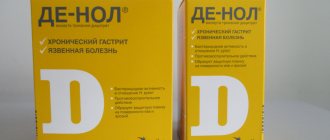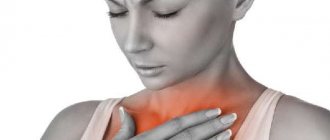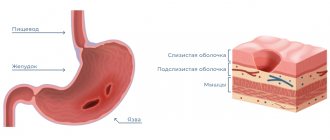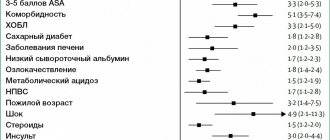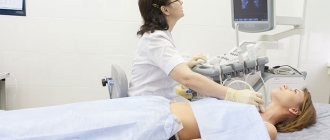Composition, dosage forms of the drug
The active substance of the drug is famotidine. The compound reduces the secretion of hydrochloric acid and increases the mucus content in gastric juice. The drug has two pharmaceutical forms:
- Tablets for oral use: in dosages of 20 and 40 mg, coated with soluble film. Auxiliary components: talc, starch, silicon dioxide, magnesium stearate. Sold in packs of 10–50 pcs.
- Lyophilized powder for the preparation of injection solutions: white or yellowish free-flowing substrate in ampoules. Available complete with solvent. Cardboard packages of the drug contain 5 ampoules, each containing 20 mg of Famotidine and excipients: mannitol, aspartic acid.
How does Famotidine work?
This is an antiulcer drug. It affects the functions of the gastric mucosa, comprehensively suppressing the production of hydrochloric acid:
- basal;
- stimulated by the enzymes gastrin, pepsin and acetylcholine.
As a result of acid neutralization, the pH level increases, and at the same time the protective effect of gastric secretions increases. Thanks to the production of glycoproteins, alkaline components and prostaglandins, the mucous membrane experiences less irritation, recovers and heals faster. In addition, the drug has a moderate effect on liver enzymes. This helps stop internal bleeding, prevents its development, and accelerates the scarring of ulcerative lesions.
The product dissolves in the stomach cavity within 10–15 minutes. The therapeutic effect of the drug develops over 1 hour and lasts up to 0.5–1 day. One dose of Famotidine significantly reduces the synthesis of hydrochloric acid for up to 12 hours, eliminating characteristic symptoms: stomach pain, heartburn.
Pharmacodynamics and pharmacokinetics
The active component suppresses the production of basal hydrochloric acid in the stomach, as well as that stimulated by acetylcholine , histamine and gastrin HCl. Reduces the activity of pepsin, increases the pH of gastric juice, and reduces the production of HCl.
By increasing the level of glycoproteins , increasing the formation of gastric mucus, stimulating the synthesis of prostaglandins , and the secretion of bicarbonate, the protective and wound-healing effect of the drug is achieved.
The drug helps stop gastric bleeding , promotes healing of damage to the gastric mucosa, and scars stress ulcers .
The drug has a weak effect on the oxidase system of the cytochrome P450 enzyme in the liver system (suppressive effect).
The medicine begins to act within an hour and lasts 12-24 hours. With intravenous administration of solutions with the active ingredient famotidine, the effect is recorded after half an hour. A single dose suppresses secretion for 10-12 hours.
Indications for use of Famotidine
The drug is prescribed for increased acidity of gastric juice and associated pathologies of the gastrointestinal tract:
- gastritis;
- attacks of heartburn, sour belching and other dyspeptic disorders;
- peptic ulcer disease, including stress ulcers;
- stomach bleeding;
- erosive lesions of the intestinal mucosa;
- Zollinger-Ellison syndrome;
- reflux esophagitis.
Famotidine is also used to prevent internal bleeding after abdominal surgery on the stomach, as a preventive measure against aspiration of digestive secretions before using endotracheal general anesthesia. In complex therapy, it is indicated to improve the condition of polyendocrine adenomatosis and mascytosis.
special instructions
Taking Famotidine may mask symptoms indicating carcinoma in the stomach. It is recommended to exclude malignant neoplasms of the digestive tract before prescribing the drug.
The drug must be discontinued gradually to prevent rebound syndrome. With stress and long-term therapy, a bacterial infection in the stomach may develop, and further spread of microbes is possible.
Famotidine must be taken two hours after using Ketoconazole , Itraconazole to prevent their hyperabsorption.
When testing for skin reactions to histamine, it is important to consider that a histamine receptor blocker may suppress the reaction and lead to a false negative result.
Treatment involves eliminating from the diet foods that irritate the gastric mucosa.
Precautions and contraindications
The drug requires careful use in hepatosis, cirrhosis and other liver diseases, inflammation of the gallbladder, renal failure, nephritis. These pathologies increase the risk of side effects. Famotidine contraindications include:
- individual intolerance to any of its components;
- oncological diseases of the gastrointestinal tract;
- pregnancy at all stages;
- lactation period.
In pediatrics, the medication is used with caution, in doses strictly determined by the doctor, with constant monitoring of the well-being of children.
Famotidine slows down the breakdown of indirect anticoagulants, antidepressants, caffeine, drugs based on lidocaine, theophylline, metronidazole, phenytoin, buformin. This must be taken into account during simultaneous courses of treatment.
Interaction
Famotidine inhibits the metabolism of Diazepam , aminophenazone, phenazone , lidocaine, caffeine, tricyclic antidepressants , phenytoin, indirect anticoagulants, Aminophylline , metronidazole, Metoprolol, buformin , glipizide, theophylline, metoprolol, clavulanic acid in the liver.
When taking drugs that depress bone marrow, the risk of developing neutropenia increases. Famotidine reduces the absorption of Ketoconazole and Itraconazole .
Sucralfate and antacids slow the rate of absorption. Famotidine is compatible with sodium chloride, dextrose solution. The drug increases the absorption of clavulonic acid, Amoxicillin .
How to use Famotidine: instructions
The medication in tablets is taken 1-2 times a day:
- 1 tablet 20 or 40 mg once: to reduce the acidity of gastric juice, to prevent relapses of gastric diseases, for reflux esophagitis;
- 20–40 mg up to 4 times a day: for Zollinger-Ellison syndrome and the risk of internal bleeding;
- 20 mg - 2 hours before surgery.
The maximum daily dose of the drug is 160 mg. The duration of treatment is 4–8 weeks. The exact treatment regimen depends on the type of disease and is adjusted by the doctor. The tablets should be taken before or after meals, without chewing, with water at room temperature. If necessary, the drug can be taken before bedtime.
Before administration, the lyophilisate is diluted in saline solution: 5–10 ml of sodium chloride 0.9%. Injections are given intravenously:
- 20 mg once: before surgery;
- repeating injections every 12 hours: for diseases of the digestive system, internal bleeding.
It is necessary to reduce the dosage of the drug gradually to avoid a possible reactive increase in the synthesis of hydrochloric acid. During the treatment period, it is important to follow a special diet: exclude foods that stimulate the secretion of gastric juice.
Famotidine price, where to buy
The price of Famotidine in 20 mg tablets ranges from 30 to 50 rubles per pack of 20 pieces.
- Online pharmacies in RussiaRussia
- Online pharmacies in UkraineUkraine
ZdravCity
- Famotidine tablets p.p.o.
20 mg 20 pcs. LLC HEMOFARM 41 rub. order - Famotidine tablets p.p.o. 40 mg 30 pcs. LLC HEMOFARM
92 rub. order
- Famotidine tablets p.p.o. 20 mg 30 pcs. LLC HEMOFARM
61 rub. order
- Famotidine tab. p/o captivity. 40 mg No. 20 LLC HEMOFARM
73 rub. order
- Famotidine tablets p.p.o. 20 mg 20 pcs. Ozone LLC
30 rub. order
Pharmacy Dialogue
- Famotidine (tab. p/p vol. 40 mg No. 30) Hemofarm LLC
79 RUR order
- Famotidine (tab.p.pl/vol. 20 mg No. 30) Ozone LLC
37 RUR order
- Famotidine tablets 40 mg No. 30 Hemofarm
78 RUR order
- Famotidine (tablet p/o 20 mg No. 20)Hemofarm
39 RUR order
- Famotidine (tablet p/o 20 mg No. 30)Hemofarm
68 RUR order
show more
Pharmacy24
- Famotidine-Pharmex 20 mg No. 5 solution TOV "Pharmex Group", Borispil, Ukraine
195 UAH. order - Famotidine-KMP 20 mg N20 tablets PAT "Kievmedpreparat", Ukraine
8 UAH order
- Famotidine-Darnitsa 0.02g N20 tablets PrAT” Pharmaceutical company “Darnitsa”, Ukraine
10 UAH.order
Side effects
According to the instructions for Famotidine, the following are possible with its use:
- reactions from the digestive system: dry mouth, loss of appetite, nausea, feeling of fullness in the stomach;
- from the central nervous system: tinnitus, dizziness, decreased vision, tremor;
- from the genitourinary system: delayed diuresis, disruption of the menstrual cycle, decreased libido;
- from the heart and blood vessels: changes in heart rate, bradycardia, decreased blood pressure.
In case of overdose, vascular collapse, vomiting, loss of coordination, confusion, acute pancreatitis, drug-induced hepatitis, bronchospasm, and myalgia are likely.



